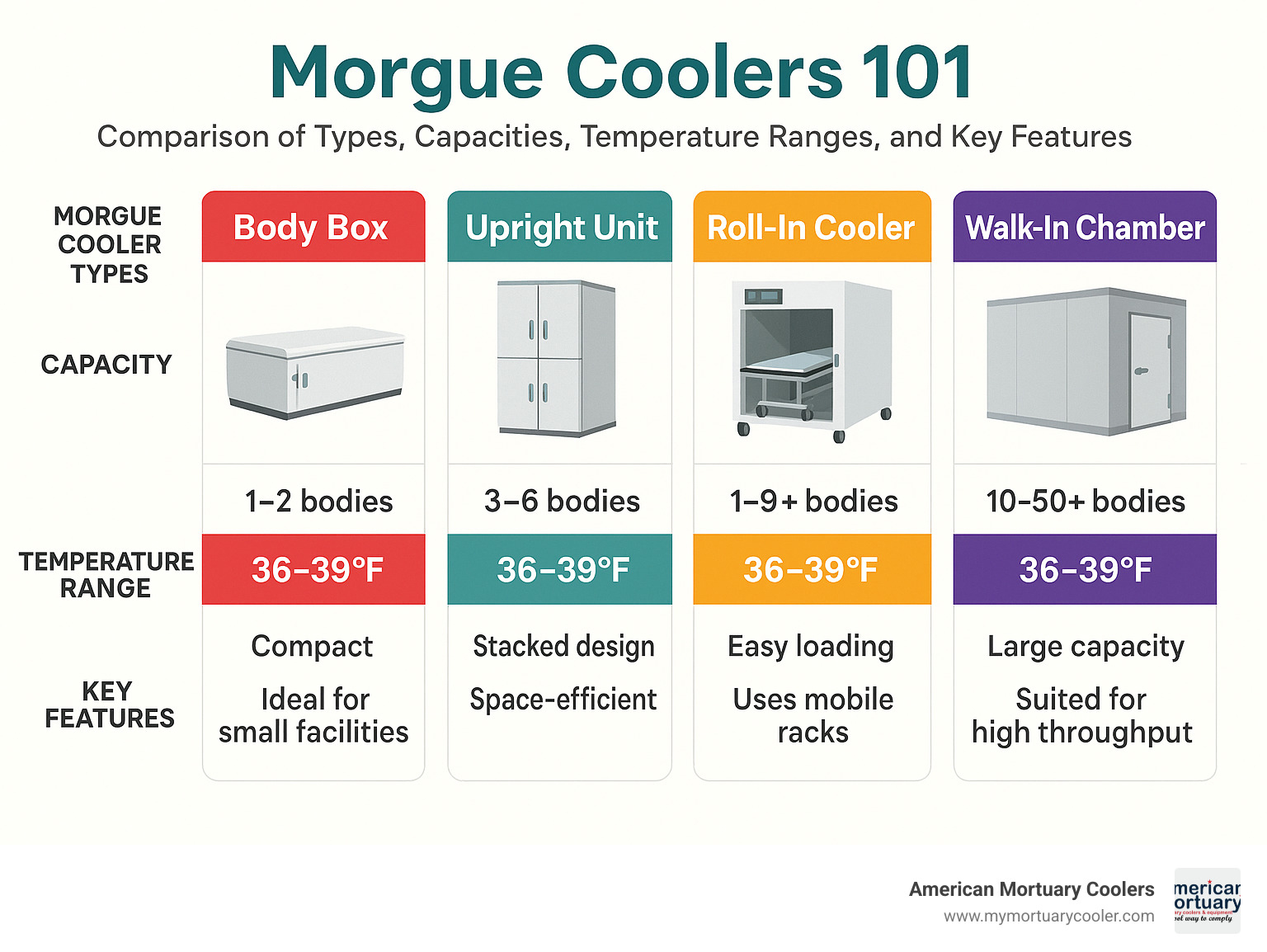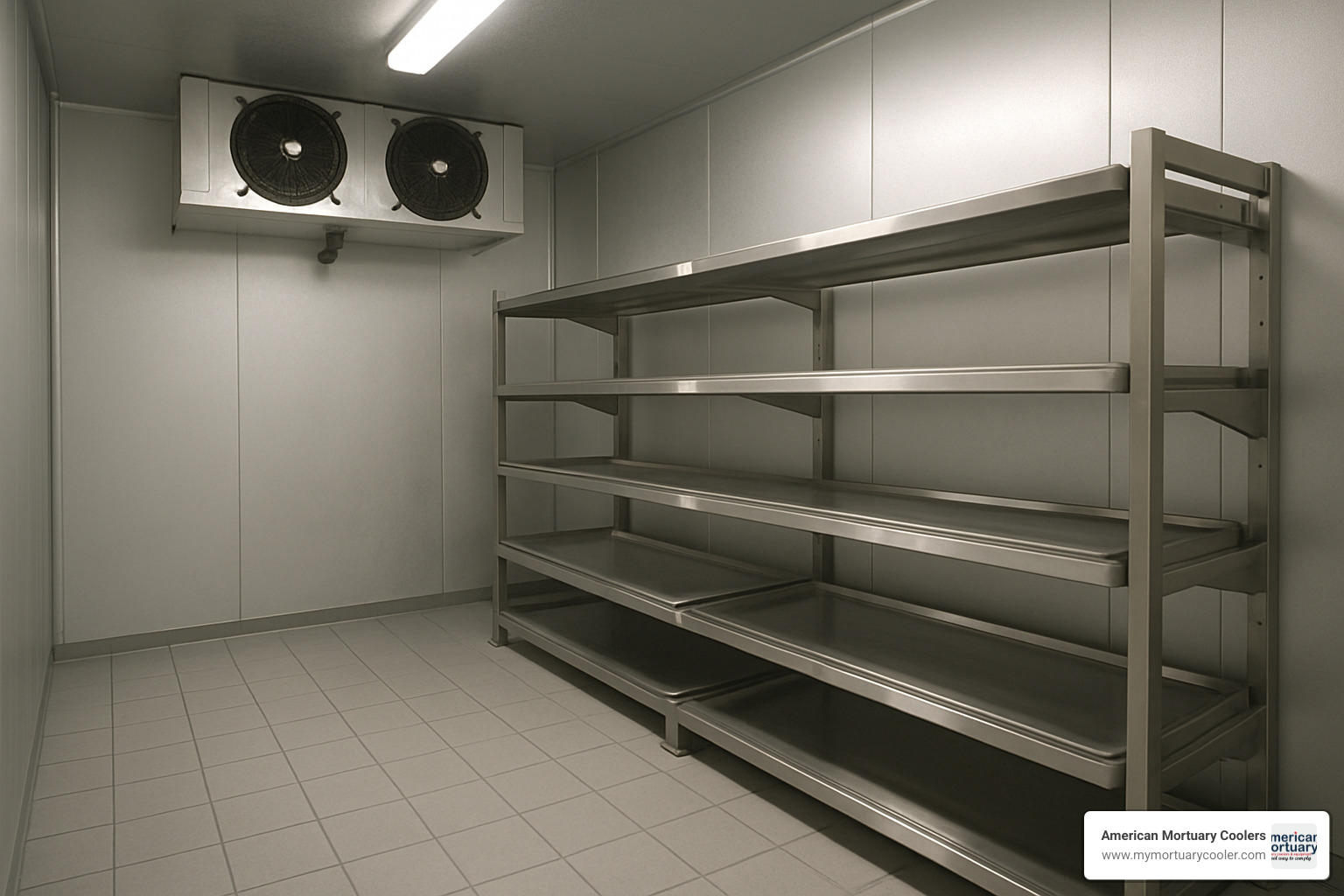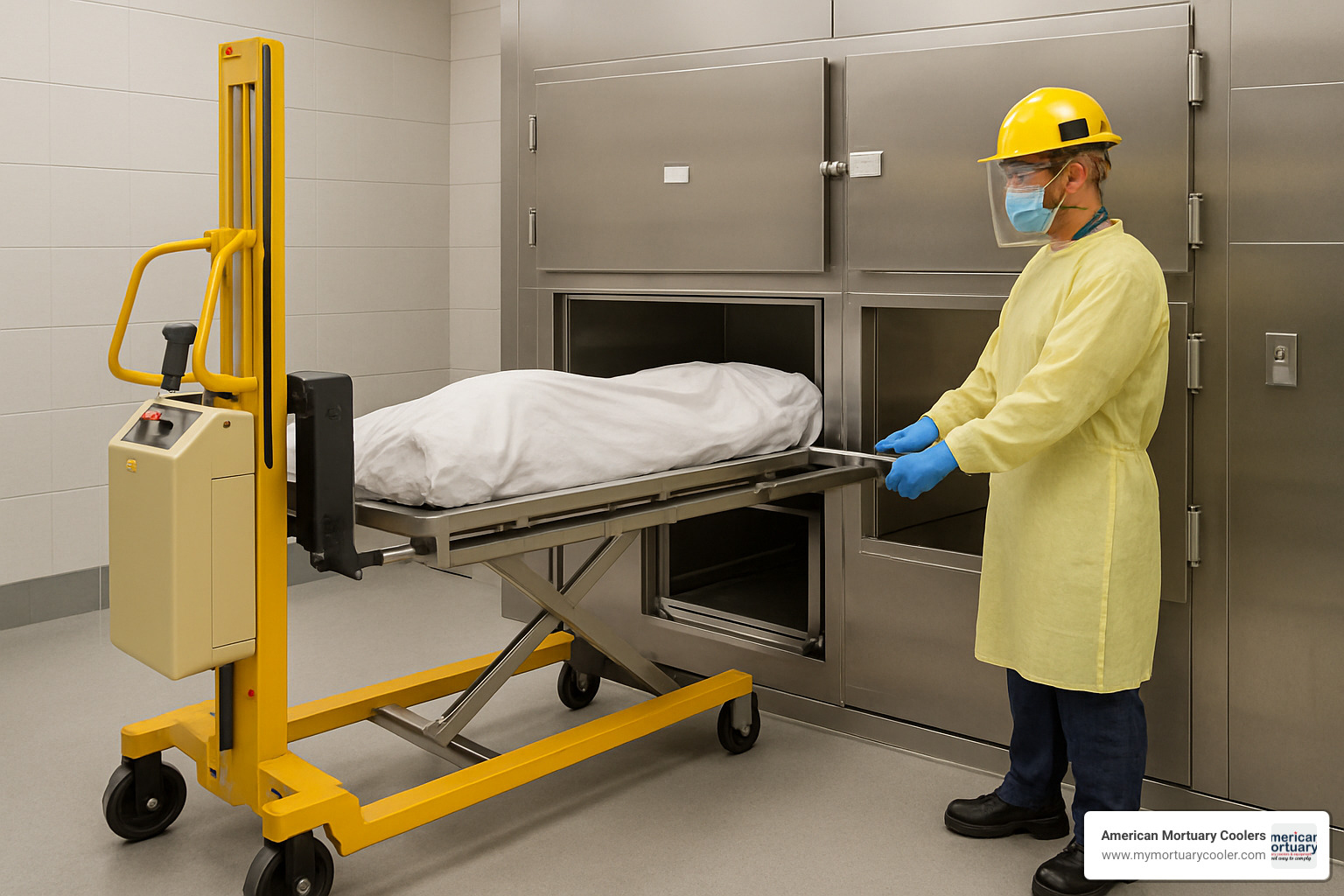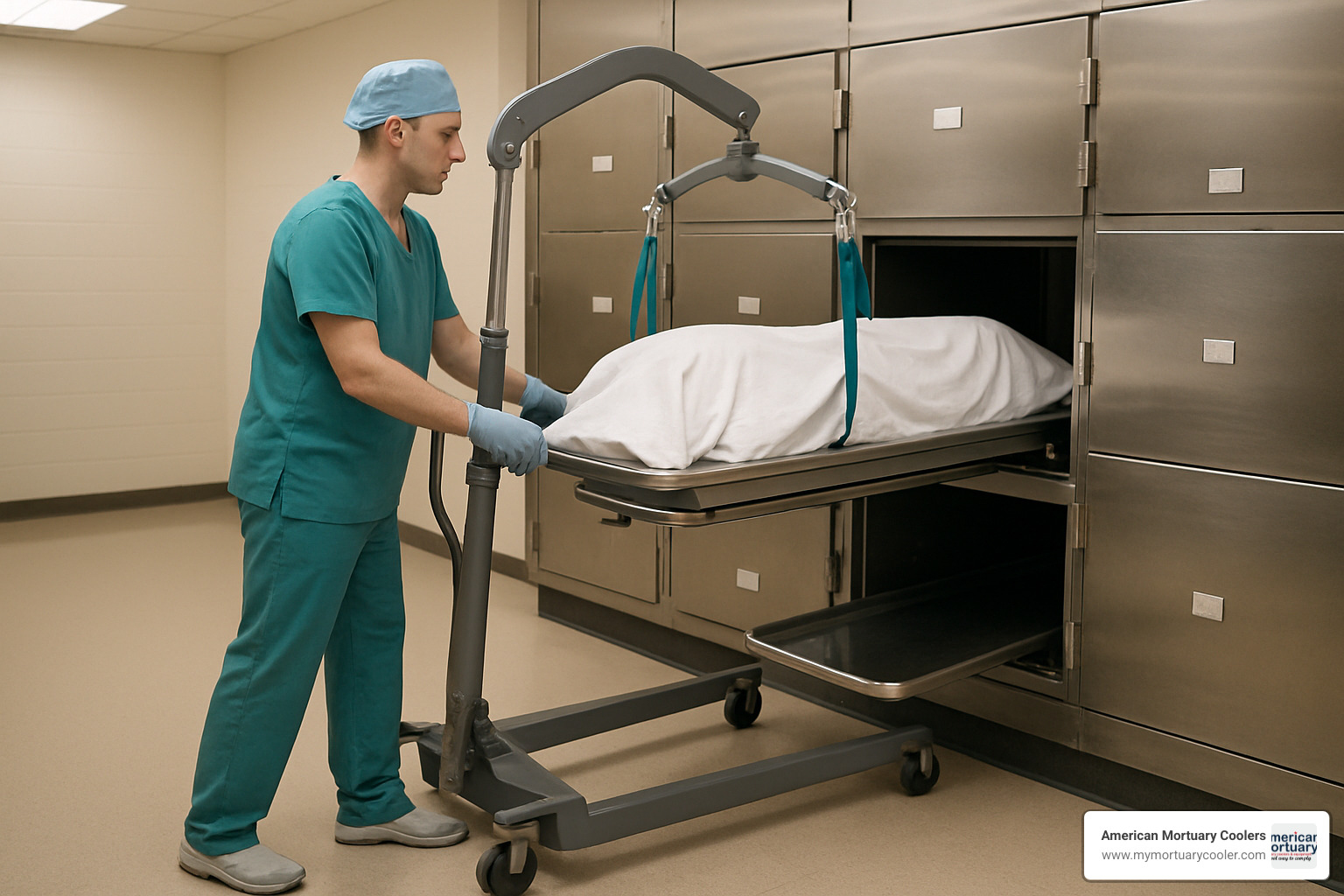Why Morgue Coolers Are Essential for Modern Funeral Facilities
Morgue coolers are specialized refrigeration units designed to slow decomposition by maintaining bodies at temperatures between 36°F and 39°F in sterile, controlled environments. These systems give families time to grieve and plan funeral services while preserving the dignity of their loved ones.
Quick Facts About Morgue Coolers:
- Temperature Range: 36°F to 39°F for standard preservation
- Capacity Options: 2-body units to 50+ body walk-in systems
- Types Available: Body boxes, upright units, roll-in coolers, walk-in chambers
- Power Requirements: Most plug into standard 110V outlets
- Typical Cost: $6,095 for 2-body units to $10,000+ for larger systems
- Warranty: 15-year panels/doors, 5-year mechanical parts (industry standard)
The mortuary industry has evolved significantly, with these cooling systems becoming standard equipment in funeral homes, hospitals, and coroner facilities nationwide. Modern morgue coolers range from compact 2-body units perfect for small funeral homes to massive walk-in systems capable of storing 50+ bodies with advanced rack systems.
I'm Mortuary Cooler, a national-level mortuary cooler supplier with extensive experience helping funeral facilities across all 50 states select the right refrigeration solutions.

Key terms for morgue coolers:
What Are Morgue Coolers and How Do They Work?
Morgue coolers exist for one essential reason: giving families the time they need to say goodbye properly. These specialized refrigeration systems slow the natural decomposition process by maintaining a carefully controlled environment that preserves human remains with dignity.
At room temperature, natural biological processes move quickly. But when you cool things down to that sweet spot between 36°F and 39°F, everything slows to a crawl. The refrigeration cycle in morgue coolers works similarly to commercial walk-in coolers, but with components specifically designed for mortuary use.
Insulation quality makes all the difference. High-quality morgue coolers use panels with impressive R-values - that's the measure of how well they keep the cold in and heat out. Standard panels range from R-21 (with 3" thickness) up to R-43 (with 5⅜" thick panels for freezer applications).
Modern cooling approaches have evolved beyond traditional compressors. While vapor-compression systems remain the gold standard, innovative solutions like CoolBot technology paired with standard air conditioners have gained popularity among budget-conscious facilities.
Digital controllers have revolutionized temperature management. Today's morgue coolers feature precise digital controls with data logging, alarm functions, and even WiFi connectivity for remote monitoring. When temperature drifts outside that critical 36-39°F range, you'll know immediately.
Key Components Inside Morgue Coolers
The evaporator coil sits inside the cooler, quietly absorbing heat from the air. Quality units use corrosion-resistant coatings because mortuary environments are humid, and cleaning chemicals can be harsh on standard metals.
Your condenser unit works outside the cooler, releasing absorbed heat. Door gaskets create the airtight barrier that keeps temperatures stable. LED lighting provides bright, respectful illumination without generating excess heat. Every walk-in morgue cooler must include OSHA-compliant safety release mechanisms.
Morgue Coolers & Decomposition Control
The science behind morgue coolers is straightforward. At normal room temperature around 70°F, enzymes and bacteria naturally present in human tissue work quickly. Enzyme activity slows by about 50% for every 18°F temperature drop. When you cool remains to that optimal 36-39°F range, those biological processes nearly stop.
This precise temperature control delivers real benefits: Extended preservation time means bodies can be safely stored for weeks rather than days. Odor reduction is nearly complete since minimal bacterial activity means virtually no decomposition smells. Flexible scheduling becomes possible when you're not racing against decomposition.
Types of Morgue Coolers & Choosing the Right Capacity
When selecting morgue coolers for your facility, you'll find several distinct types designed to meet different needs and space constraints.
Walk-in coolers represent the gold standard for high-capacity storage. These spacious units can accommodate anywhere from 9 to 50+ bodies, depending on their size and internal rack configuration. Built with modular, prefabricated panels, walk-in systems offer incredible flexibility.
Upright coolers provide an excellent middle ground. These cabinet-style units typically store 2-4 bodies while taking up minimal floor space. They plug right into standard 110V outlets without any special electrical work.
Roll-in coolers shine when workflow efficiency matters most. These units integrate seamlessly with your existing mortuary cots, allowing staff to wheel remains directly into the cooling chamber.
Body box coolers offer the most straightforward solution for smaller operations. Available in 2-body, 3-body, and 4-body configurations, these compact units often come with optional casters for mobility. Pricing starts around $6,095 for a basic 2-body unit.

Morgue Coolers in Small Facilities
Small funeral homes and rural hospitals often find morgue coolers in the 2-4 body range hit the sweet spot between capacity and practicality.
2-body systems work beautifully for facilities handling 1-3 cases weekly. At $6,905, these units provide exceptional value for smaller operations. The beauty lies in their plug-and-play design - no electrician or plumber required.
3-body systems suit facilities that need a bit more capacity or want backup storage during unexpectedly busy periods. Optional casters ($885) let you reposition these morgue coolers as needed.
Large-Scale Morgue Coolers for Hospitals & Coroners
High-volume facilities need morgue coolers that can handle substantial capacity while maintaining reliability under constant use. Walk-in systems dominate this space, offering storage for dozens of bodies with sophisticated features.
Walk-in capacity options scale beautifully with your needs. Medium-volume facilities often choose 8-10 body systems, while busy hospitals typically need 16-20 body capacity. High-density rack systems transform how efficiently you use available floor space.
| Feature | Body Box Coolers | Walk-in Coolers |
|---|---|---|
| Capacity | 2-6 bodies | 9-50+ bodies |
| Installation | Plug-and-play | Professional required |
| Mobility | Optional casters | Permanent installation |
| Cost Range | $6,095-$10,454 | $15,000-$100,000+ |
| Power Requirements | 110V standard | 208-230V typical |
Buying Considerations: Features, Energy, Compliance & Cost
When you're ready to invest in morgue coolers, the right choice balances upfront costs with long-term performance, energy efficiency, and regulatory compliance.
Panel thickness directly impacts your monthly utility bills. 3-inch panels offer an R-value of 21, while 4-inch panels deliver R-values of 28 for standard coolers. Premium 5⅜-inch panels provide impressive R-values of 37.6 for coolers and 43 for freezers. Thicker panels cost more upfront but typically pay for themselves through lower energy bills.
Federal compliance isn't optional. All morgue coolers must meet DOE/EISA rules under the Federal Energy Independence & Security Act of 2007. Your panels need ASTM E84 testing for smoke and flame spread requirements. Components should carry UL-NSF approval and meet OSHA safety standards.
Energy efficiency becomes more important as utility costs rise. Larger units are typically more efficient per cubic foot. Your local climate matters too - facilities in hot climates work harder to maintain those crucial 36-39°F temperatures.
Lifecycle costs tell the real story of your investment. Industry standard warranties typically include 15 years on panels and doors with 5 years on mechanical components. Financing options can make a significant difference in your cash flow, with many suppliers offering 0% down payment programs and equipment leasing arrangements.
More info about temperature standards provides detailed guidance on regulatory requirements.
Essential Accessories for Morgue Coolers
Storage trays and racks form the backbone of your cooling system. Stainless steel grade 304 trays come in 23", 27", and 30" widths. Cantilever rack systems make loading and unloading much easier.
Hydraulic and battery-powered lifts protect your staff from injury while improving workflow. Modern lifts handle up to 1,000 pounds while weighing just 395 pounds themselves.
Alarm systems ($775) provide critical monitoring with WiFi connectivity for remote monitoring, temperature history logging, and multiple alert methods. CoolBot Pro systems offer WiFi-enabled temperature alerts and mobile app control.

Space & Installation Planning
Getting your morgue cooler installation right the first time saves headaches, money, and delays.
Floor versus floorless decisions affect both your budget and daily operations. Floorless units cost less upfront and work perfectly on existing concrete floors. Floor-included units provide better insulation and make cleaning easier.
Doorway clearance often determines whether your unit arrives assembled or needs on-site construction. Measure your door opening dimensions, hallway widths, and ceiling height restrictions.
Electrical requirements range from simple plug-in to complex installations. Small morgue coolers connect to standard 110V outlets. Larger units may require 208-230V connections that need professional installation.
Installation, Maintenance & Best Practices
Getting your morgue coolers up and running properly sets the foundation for years of reliable service. The installation process starts with solid groundwork - your flooring needs to be level and sturdy enough to handle the weight of a fully loaded unit.
For smaller morgue coolers, installation is surprisingly straightforward. Most manufacturers rate basic models as "Level 1" difficulty, taking about an hour with common tools. Walk-in systems need professional installation teams who understand modular panel assembly and refrigeration connections.
Daily maintenance keeps everything running smoothly. A quick glance at the temperature display, checking door seals, and general cleanliness takes just minutes. Weekly tasks include reviewing temperature logs and interior sanitization. Monthly maintenance involves condenser coil cleaning and drain pan inspection.

Sanitation protocols deserve special attention in mortuary settings. EPA-approved disinfectants designed for mortuary use work best, and you'll want to document all cleaning activities for compliance purposes.
Safe & Respectful Body Handling Inside a Cooler
Working with morgue coolers requires balancing operational efficiency with the dignity and respect that every family deserves.
Ergonomics matter tremendously in this work. Mechanical lifts should be your first choice for transfers whenever possible. Telescoping slide-rail systems allow individual tray access without disturbing others.
Identification systems prevent the mix-ups that can devastate families. Secure tagging systems need to withstand cold temperatures and moisture while remaining clearly visible.
Privacy and cultural considerations often get overlooked but matter deeply to families. Opaque storage bags respect family concerns, while separate storage areas accommodate specific cultural or religious requirements.

More info about storage tray options provides detailed guidance on selecting appropriate storage systems.
Frequently Asked Questions about Morgue Coolers
What temperature should a morgue cooler run at?
The sweet spot for morgue coolers is 36°F to 39°F - this narrow range makes all the difference in proper preservation. At these temperatures, you're slowing decomposition dramatically while keeping tissues in excellent condition for viewing and embalming.
For forensic work or very long-term storage, freezer units at 0°F or below serve a different purpose entirely. But freezing damages tissues and makes embalming much more difficult. That's why most funeral homes stick with standard cooling temperatures.
How do I determine the correct size for my facility?
Sizing morgue coolers correctly means looking at your business from several angles.
Start with your weekly volume. If you're handling 2-3 cases per week, a 3-4 body cooler gives you comfortable capacity. But if you're a busy hospital dealing with 10+ cases weekly, you're looking at 20-50 body walk-in systems.
Plan for the unexpected. Every facility faces surge events - car accidents, flu outbreaks, natural disasters. Having 25-50% extra capacity isn't wasteful; it's smart planning.
Consider your storage patterns. Some facilities move bodies quickly through their system, while others hold remains longer for complex services or family travel.
Are morgue coolers energy-efficient?
Modern morgue coolers are surprisingly efficient, especially compared to older systems. High-quality insulation makes the biggest difference. Panels with R-values of 28-43 keep cold air where it belongs.
Smart components also help. ECM fans use less electricity while moving air more effectively. Digital thermostats with WiFi connectivity let you monitor and adjust temperatures remotely.
Most morgue coolers cost $200-800 annually to operate. A 3-body unit might cost $300 per year, while a large walk-in system could reach $800.
Conclusion
Finding the perfect morgue coolers for your facility doesn't have to feel overwhelming. Whether you're a small funeral home needing your first 2-body unit or a busy hospital requiring a sophisticated walk-in system for 50+ bodies, the right solution exists for your specific situation.
The fundamentals remain consistent across all morgue coolers: maintaining that critical 36-39°F temperature range, ensuring energy efficiency through quality insulation, and meeting federal compliance standards. But beyond the technical specs, these systems serve a deeper purpose - giving families the precious time they need to grieve and plan meaningful services for their loved ones.
Modern morgue coolers have come a long way from basic refrigeration boxes. Today's units feature digital controls that let you monitor temperatures from your phone, energy-efficient designs that keep utility bills reasonable, and safety systems that protect your staff.
At American Mortuary Coolers, we've spent years helping facilities across all 48 contiguous states steer these choices. Based right here in Tennessee, we understand that every funeral home, hospital, and coroner's office faces unique challenges. Your space constraints aren't the same as the facility down the road. Your budget considerations are different. Your community's needs are unique.
That's why we don't believe in one-size-fits-all solutions. A rural funeral home might thrive with a simple plug-and-play 2-body unit starting at $6,905. A metropolitan hospital might need a complex walk-in system with advanced monitoring and redundant cooling. Both deserve equipment that serves their community reliably for decades.
The investment you make in quality morgue coolers ripples through everything you do. Families gain peace of mind knowing their loved ones are cared for with dignity. Your staff works more efficiently with proper equipment. Your facility operates smoothly even during challenging times.
The mortuary industry continues evolving, and we're committed to evolving with it. Modular panel systems now allow future expansion without starting over. Smart monitoring prevents problems before they affect your operations. Energy-efficient designs respect both your budget and environmental responsibilities.
Your community depends on you during their most difficult moments. You deserve equipment that supports that vital mission without adding stress to your daily operations. Whether you need immediate solutions or are planning for future growth, we're here to help you find the perfect morgue coolers for your specific situation.
Ready to explore what's possible for your facility? Let's discuss your needs and create a solution that serves your community with the dignity and reliability they deserve.


















